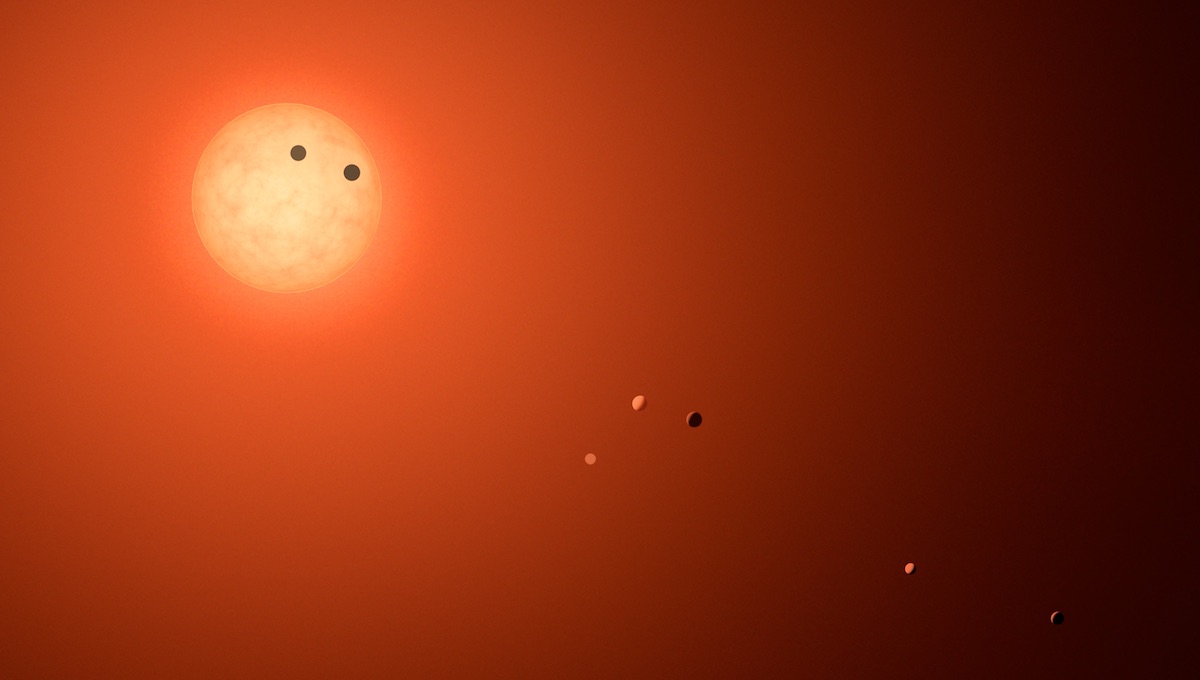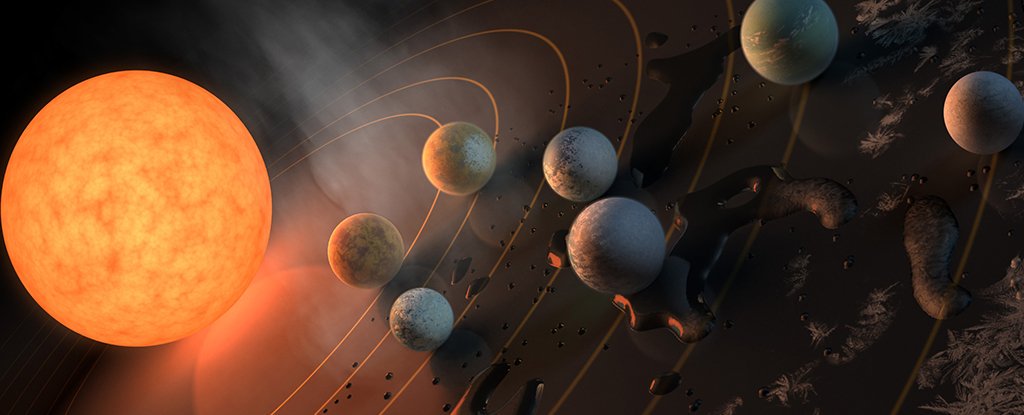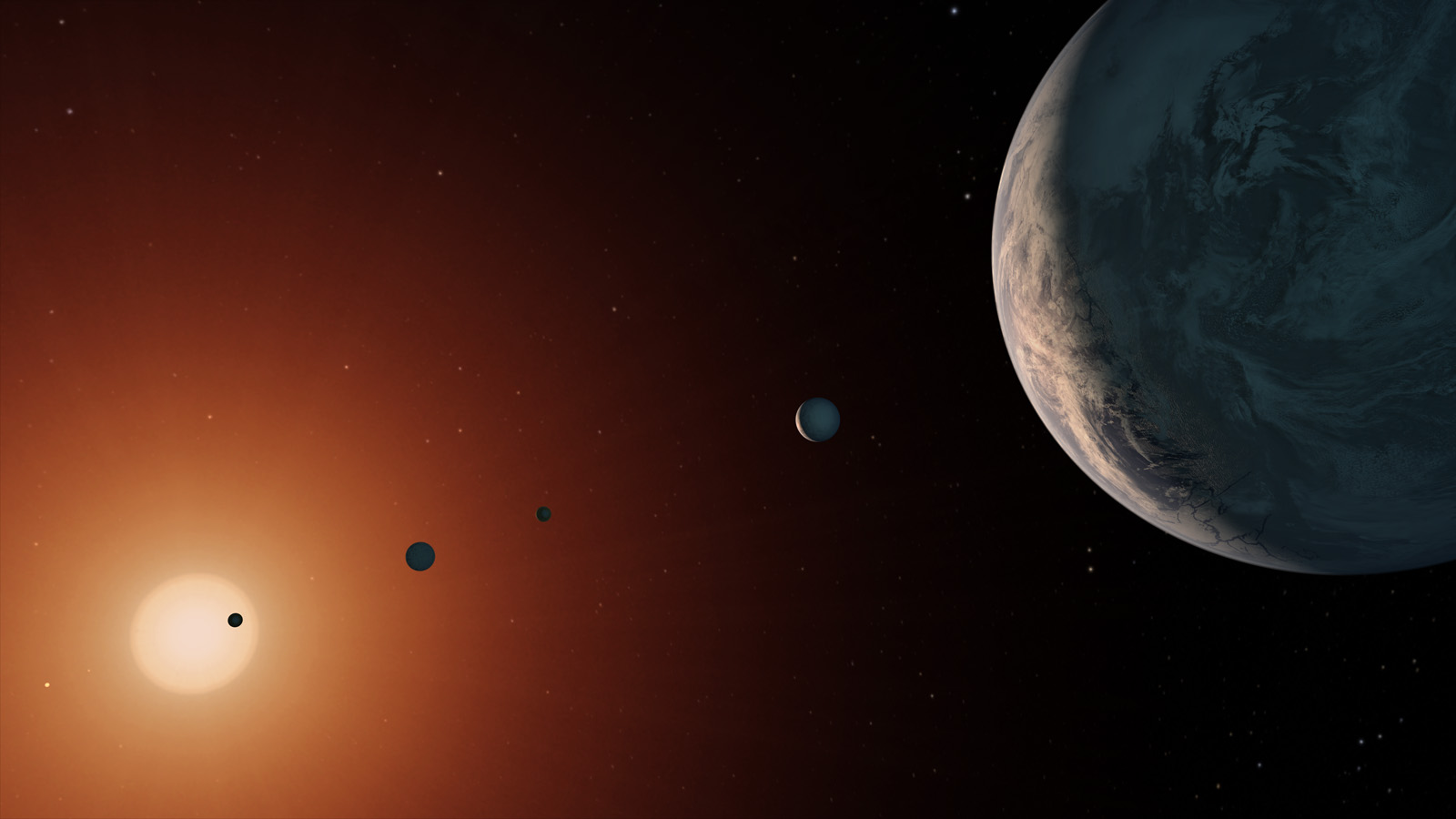 So, according to the artist, the red dwarf system might look
So, according to the artist, the red dwarf system might lookAlmost all media outlets
wrote about the discovery of the TRAPPIST-1 system with a small star and several exoplanets at once in a potentially habitable zone last year, even those that have nothing to do with science and its achievements. But there is no reason to be surprised here, since the star (its catalog number 2MASS J23062928-0502285) in TRAPPIST-1 was found immediately seven exoplanets, three of which are in the so-called potentially habitable zone. That is, they are removed from their star at a distance that is optimal for the existence of water in liquid form on their surface.
The rest of the planets in this system are outside the so-called habitable zone, so that they are either too hot or too cold for the existence of water there. But at once three planets on which life can exist are more than what scientists had previously seen in other star systems. There is a hope that the planets are really habitable.
True, it was soon suggested that organic life could not exist on
TRAPPIST-1 exoplanets due to the activity of its star. And now astronomers have shown that all planets close to a star in this system are likely to be heated to very high temperatures.
It's all about the magnetic field of the star. A team of scientists from Europe discovered that the TRAPPIST-1 magnetic field is very strong. It can create something like a microwave effect, warming the planets nearby so much that lava is splashing on their surface instead of water.
Induction heating is what we often use on our planet. Induction heating is the heating of materials by electrical currents that are induced by an alternating magnetic field. The magnetic field excites eddy currents, for example, in a metal product. But the same may be relevant for non-metallic objects, moreover, very large.
In our solar system there is no such danger, since the planets and their satellites are far enough away from sources of powerful magnetic radiation, which can provoke heating. This, in particular, is relevant for our system - there is no such threat for any of its planets. But this situation is often found in other systems, where the planets are much closer to their star than in the solar system.
In order for induction heating to work, the magnetic field must often change. The planet is heated by the star’s magnetic field if the star-planet system meets the following criteria: the planet rotates rapidly, its magnetic fields do not coincide with the axis of rotation (for example, the situation on Earth). All this provides the possibility of heating the planets in the system.
The star TRAPPIST-1 belongs to the
class of dwarfs of type M. Stars of this type are small, relatively cold. But the habitable zone is much closer to the star than in other systems. In addition, the magnetic field of such stars is thousands of Gauss. The magnetic field around the sun is about 1000 times weaker.
Another factor that is needed for heating is the rapid rotation of the star. For example, Proxima Centauri rotates quickly, the Sun is slower. And TRAPPIST-1 makes a complete turn around its axis in just three days. Scientists who study the problem of heating planets in the Trappist -1 system have built a mathematical model to evaluate the effect of a star on their planets.
This star has a magnetic field with an induction of 600 Gauss. In their model, scientists used a different star circulation time of 1.4 days.

However, the key indicator here is not even the period of revolution around its axis, but the type of materials from which the planets of the system are composed. The intensity of the heating of the planet during the action of magnetic induction largely depends on the type of materials of which the planet is folded. Unfortunately, due to the remoteness of Trappist-1, it is not possible to assess the mineralogical and chemical composition of the exoplanets of the system.
If we take as a basis the assumption that the composition of the three Trappist-1 exoplanets in close proximity to its star is similar to Earth, we can draw a number of conclusions. The first is that due to magnetic induction, these planets are heated outside, that is, the core of the star is exposed to the crust of the planets. This is their difference from the Earth, which is heated from the inside.
Most likely, the third planet of the system seems to be heating up if we keep score from the nearest planet to the star. She gets 60% of her star's magnetic induction energy. And this is enough to turn the planet into a hot stone ball. One can doubt about the ocean of magma, since for a magnetic field there is a limitation on the depth of penetration. But it is known that the heating of the planet leads to the intensification of its volcanic activity. So it is likely that on the planets Trappist-1, located near the star, high activity of volcanoes, which literally fill the surface with lava.
But even if there are no oceans of liquid lava on the surface of the Trappist-1 planets, all the same, there must be hot enough to talk about the complete absence of living organisms on such a planet.
As you can see, there are many assumptions, but most likely they are correct, since the Hubble orbital telescope observations were used as the basis for the study. Another assumption is the effect of the possible magnetic field of the planet itself on induction. Some researchers believe that the planets of the Trappist-1 system have a magnetic field (this is quite possible if they have a liquid core). In this case, the local field of the planet can affect the intensity of induction.

The existence of the system
became known in May 2016 thanks to a joint team of astronomers from Belgium and the United States. The discovery was made using the TRAPPIST robotic 0.6 meter telescope (
TRAnsiting Planets and PlanetesImals Small Telescope ), located at the ESO La Silla Observatory in Chile. Three of the seven planets were discovered by the transit method, that is, they were discovered when the planets passed through the star's disk. By the depth of the eclipse, you can determine the size of the planet that passes on the disk, which was done.
After it became clear that there are exoplanets in the system, astronomers who discovered them received permission to use extra time to work with the NASA Spitzer telescope. As a result, it turned out that there are more darkening of the star's disk, than it could be if there are only three planets in this system. So four additional exoplanets were discovered. All seven received the designations TRAPPIST 1 b, c, d, e, f, g, and h. Initially it was thought that there are several potentially habitable planets, those that are not too far away, but not too close to their star.
Some time after the discovery of Trappist-1, some experts began to argue that life on the planets of the system could not
even be
in the habitable zone . The fact is that the star itself is a red dwarf. This class of stars is characterized by frequent flashes. They are not as powerful as on the Sun, but since the planets are closer to the star, flashes can even blow the atmosphere off the planets. On such planets, even relatively modest flares can have a strong effect on planetary conditions.
Therefore, even resilient microorganisms can hardly withstand the conditions of such a star. In addition to radiation, there are other factors affecting the planets revolving around their luminaries.
Recently, scientists have found that it affects the planets and the magnetic field of a star, which plays a peculiar role of the microwave. If everything is really as European astronomers assume, then there can be no life in this system. Moreover, the planets in the habitable zone cannot have a more or less dense atmosphere, as well as water in a liquid form on the surface of the planets or outside it. True, the question arises of what are then the distant planets.
Nature Astronomy, 2017.
DOI: 10.1038 / s41550-017-0284-0